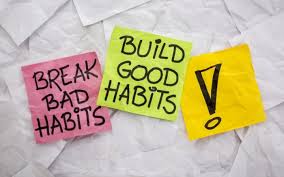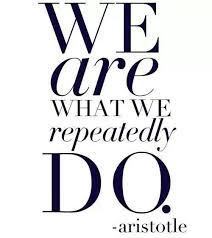In a previous article on the power of habits, we discussed how habits are a tool our brains use to be more efficient. Instead of consciously analyzing every situation,...
Using the Science of Habits to Improve Performance in School: Part I
 We write a lot on this blog about how academic success (and other types of success) is much more a function of the choices you make and the effort you put in than a function of your intrinsic or genetic talents. In other words, most recent research suggests, and we firmly believe, that academic skills are built through practice and success comes through developing better strategies and making better choices.
We write a lot on this blog about how academic success (and other types of success) is much more a function of the choices you make and the effort you put in than a function of your intrinsic or genetic talents. In other words, most recent research suggests, and we firmly believe, that academic skills are built through practice and success comes through developing better strategies and making better choices.
So where do habits fit in this story?
A habit is essentially a tool that the human brain has developed to become more efficient. Instead of spending brain power to analyze a situation and make a conscious decision, habits kick in, and we act automatically. The mental processes that power our habits can be a force for good or evil. Habits can help us sense danger and flee automatically, exercise regularly, and eat better. But they can also explain why we abuse alcohol and fight with our spouses. In The Power of Habit, Why we Do What We Do in Life and Business, Charles Duhigg argues that habits might be far more important than any other factor in explaining our successes and our failures. And this of course includes academic success.
Drawing from Duhigg’s book, in this two-part article we will:
- Introduce the “habit loop,” a framework for understanding how habits work
- Discuss how to change habits
- Discuss why habits are so important, as well as a key concept called the “keystone habit”
- Apply the theory of habits more directly to success in school
The habit loop: a framework for understanding how habits work
In Duhigg’s book, he explains that habits have four dimensions. To explain, he uses one very common habit that you probably have: brushing your teeth at night. The habit of brushing your teeth may have play out as follows:
- The cue: you feel your teeth have a bit of a film on them, or perhaps it’s just morning or night, around the time when you always brush your teeth
- The craving: when you notice that cue, you feel this intense craving for that particular tingling feeling which tells you your mouth is clean
- The routine: you brush your teeth
- The reward: your teeth are clean and shiny
Most habits play out like this. You don’t analyze the pros and cons each morning and night of brushing your teeth. You just do it. It’s a habit. Other habits work this way too. Let’s envision a well-trained high school student in the habit of doing his homework. His habit loop might be:
- The cue: I’m home from school, and I’ve had a snack
- The craving: I want to be able to tell my mom I’m done with my homework AND feel that sense of accomplishment
- The routine: do your homework
- The reward: a sense of accomplishment and freedom to do whatever you choose for the rest of the night
But let’s consider a bad habit many students have. Let’s say that whenever you are studying you have a habit of using social media or texting your friends, which is distracting and wastes time. This interrupts your studying, reduces your level of focus, and makes it harder to learn new things, finish your homework, and generally be productive.
 How do you go about changing a habit?
How do you go about changing a habit?
There is more than one way to change a habit. James Clear, a blogger on productivity, offers a range of helpful ideas about how to change habits. But one thing is clear. It is incredibly difficult to remove a habit simply by exercising willpower. You’ll be far more successful by changing a habit. To do that, it’s generally accepted that you need to a) identify the cue and b) change the routine so that you can c) realize the same or a similar reward.
Back to that habit of checking your phone when you are supposed to be studying. The solution might not be all that complicated or even interesting. Perhaps your cue is literally just seeing your phone or feeling it in your pocket. The routine is checking your various social media channels, driven by a craving to be socially connected and see what others are up to (and because you view homework as a little boring). The reward is connection with others on social media. There is a potentially very simple habit change that results in much better academic outcomes.
As we said earlier, the key to changing habits is identifying the cue and changing the routine such that you still see the reward. In this case, what if you say to yourself, you know, when I feel my phone in my pocket, and begin to crave the social connectivity that Facebook provides, instead of immediately checking my various social media channels, I’m going to commit to doing whatever I am currently doing for 20 more minutes. At that point, I’ll take a break and check Facebook. You have now substituted 20 minutes of additional studying for checking Facebook right now. At the end, you get the same reward: the ability to check Facebook and feel connected.
What are habits so important? And what is a keystone habit?
If it’s not obvious already, habits are so important because so much of what people do is controlled by them. We may think we are in control as we go about our day. But in fact, our brains our filled with lots and lots of habits, and those habits are driving how we act. Taking a shower, brushing your teeth, exercising, eating healthy foods, not getting too upset when things go poorly at home or at work, being committed to finishing a project on time, etc. – these actions are all in large part a function of habits. To change your behavior and reach your goals, you typically have to spend a lot of time identifying and modifying habits.
And, it turns out, according to the research the Duhigg cites in his book, that some habits are more powerful than others because they make it easier for other habits to take hold. Duhigg calls these “keystone habits.” In this blog post on keystone habits Sam Davies describes them as “the habits that change, remove, and re-shape your other habits. Duhigg suggests that exercising regularly tends to be a keystone habit. Once you are regularly exercising, you are more likely to stop smoking and start eating better. This seems intuitive. Once you are doing one good thing for your body, you have built up some momentum. It is good to exercise regularly but also eat well. The two habits complement themselves.
In part two of this article, we’ll explore keystone habits in a bit more detail, and discuss a number of ways to improve performance in school by leveraging the power of habits.
